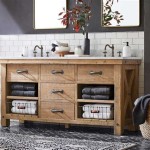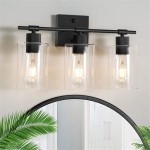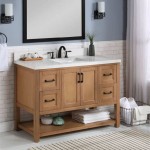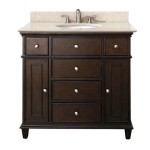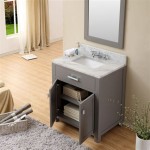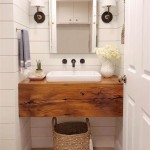Art Deco Vanities: Bringing Glamour to the Bathroom
Art Deco, a design movement that flourished during the roaring twenties and thirties, embodies luxury, modernity, and ornamentation. It's characterized by geometric shapes, rich materials, and a sense of sophisticated opulence. When applied to bathroom vanities, Art Deco elements can transform a utilitarian space into a statement of style and elegance. This article will explore the key features of Art Deco vanities, discuss the materials and design elements that define this aesthetic, and provide guidance for incorporating them into modern bathroom designs.
The Art Deco period was a reaction against the perceived excesses of Art Nouveau and the austerity that followed World War I. It embraced machine-age technology and integrated it with handcrafted artistry. In architecture and interior design, this translates to bold geometric patterns, symmetrical arrangements, and the use of luxurious materials like marble, exotic woods, and chrome. The aesthetic is one of streamlined elegance and optimistic futurism, which still resonates with designers and homeowners today.
Key Characteristics of Art Deco Bathroom Vanities
Art Deco vanities are not simply bathroom fixtures; they are focal points that showcase the era's distinctive style. Several key characteristics distinguish them from vanities of other periods.
Geometric Shapes and Symmetry: The foundation of Art Deco design lies in its geometric forms. Vanities often feature stepped designs, triangular motifs, and repetitive patterns. Symmetry is crucial, creating a sense of order and balance. Cabinet doors and drawers are typically adorned with linear details and angular handles. This geometric emphasis provides a visual structure that defines the overall look.
Luxurious Materials: Authentic Art Deco vanities would utilize high-quality materials such as marble, often in striking colors and patterns like black and white or deep greens. Exotic woods like ebony, walnut, and rosewood were also common, providing rich textures and visual interest. Chrome and other polished metals were used for hardware, adding a touch of glamour and reflecting light to enhance the overall ambiance. Replicating this look today can involve using high-quality veneers, engineered stone countertops that mimic marble, and chrome-finished fixtures.
Mirrored Accents: Mirrors are an integral part of Art Deco design, expanding space and amplifying light. Vanities often incorporate mirrored panels on the doors or sides, adding visual depth and reflecting the surrounding environment. Mirrored backsplashes can further enhance the effect, creating a sense of spaciousness and sophistication. The reflective surfaces contribute to the overall sense of glamour and luxury characteristic of the Art Deco period.
Streamlined Design: While ornate details are present, Art Deco vanities also embrace a sense of streamlining. The aim is to combine elegance with functionality, removing unnecessary ornamentation and focusing on clean lines and smooth surfaces. This emphasis on form and function contributes to the overall sense of modernity that defined the Art Deco movement.
Materials Commonly Used in Art Deco Vanities
The choice of materials is paramount in achieving an authentic Art Deco aesthetic for bathroom vanities. The following materials are commonly associated with this style and can be used individually or in combination to create a stunning effect.
Marble: Marble is a quintessential material for Art Deco bathrooms. Its natural veining and luxurious feel evoke the glamour of the era. Black and white marble combinations are particularly popular, creating a striking contrast that complements the geometric patterns. Other suitable marble colors include deep greens, browns, and creams. The texture and visual depth of marble contribute to the overall sense of opulence and sophistication.
Exotic Woods: Woods like ebony, rosewood, and walnut were frequently used in Art Deco furniture and vanities. These woods offer rich colors and distinctive grain patterns that add warmth and visual interest to the space. When using exotic woods, it is important to ensure they are sourced sustainably. Alternatives include using high-quality veneers that mimic the appearance of these woods, providing a more eco-friendly option.
Chrome and Polished Metals: Chrome and other polished metals are essential for adding a touch of glamour to Art Deco vanities. They are commonly used for hardware, such as handles, knobs, and faucet fixtures. The reflective surfaces of these metals enhance the overall ambiance of the bathroom by reflecting light and creating a sense of spaciousness. Consider using chrome or polished nickel for a classic Art Deco look, or opt for brushed brass for a more contemporary feel.
Glass and Mirrors: Glass, especially mirrored glass, plays a significant role in Art Deco design. Mirrored panels on vanity doors, mirrored backsplashes, and glass shelves can all enhance the sense of space and light in the bathroom. The reflective surfaces contribute to the overall sense of glamour and sophistication that is characteristic of the Art Deco period. Frosted glass can also be used to add privacy and texture to the design.
Lacquer and High-Gloss Finishes: High-gloss finishes, particularly lacquer, were popular in Art Deco furniture. Applying a high-gloss finish to the vanity cabinet can create a sleek and modern look while also highlighting the geometric shapes and patterns. Lacquer finishes are durable and easy to clean, making them a practical choice for bathroom vanities. Consider using bold colors like black, white, or deep red for a dramatic effect.
Integrating Art Deco Vanities into Modern Bathroom Design
While Art Deco is a distinct style, it can be seamlessly integrated into modern bathroom designs. The key is to balance the Art Deco elements with contemporary features to create a cohesive and stylish space.
Balancing Ornate and Minimalist Elements: Art Deco is known for its ornamentation, but it's important to avoid overwhelming the space. Pair an Art Deco vanity with minimalist fixtures and accessories to create a balanced look. For example, a vanity with intricate geometric details can be complemented by a simple, frameless mirror and clean-lined faucet fixtures. The contrast between the ornate and minimalist elements will create visual interest without sacrificing the overall sense of order and calm in the bathroom.
Color Palette Considerations: The Art Deco color palette typically includes bold colors like black, white, gold, and deep reds, as well as softer shades of cream, beige, and pastel pink. When incorporating an Art Deco vanity into a modern bathroom, consider using a neutral color palette for the walls and floors to allow the vanity to be the focal point. Accents of gold or chrome can be added through hardware and accessories to tie the look together. Avoid using too many competing colors, as this can create a cluttered and overwhelming effect.
Lighting Design: Lighting is crucial for showcasing the beauty of an Art Deco vanity. Consider using sconces with geometric shapes or pendant lights with frosted glass shades to create a soft and flattering light. Wall-mounted lights can be positioned to highlight the details of the vanity and add depth to the space. Avoid using harsh or overly bright lighting, as this can detract from the overall sense of glamour and sophistication. Dimmable lighting is ideal for creating a relaxing and inviting atmosphere.
Accessorizing with Art Deco Elements: To further enhance the Art Deco aesthetic, consider accessorizing the bathroom with other Art Deco-inspired elements. This could include geometric-patterned towels, vintage-style soap dispensers, and decorative mirrors with stepped frames. Even small details like these can make a big impact and help to create a cohesive and stylish space. Avoid using too many accessories, as this can create a cluttered look. Instead, focus on a few carefully chosen pieces that complement the overall design.
Modern Interpretations of Art Deco: There are many modern interpretations of Art Deco vanities that incorporate contemporary materials and finishes. For example, a vanity with a marble countertop and chrome hardware can be paired with a sleek, minimalist cabinet in a neutral color. This approach allows you to capture the essence of Art Deco while still maintaining a modern and functional bathroom design. Consider exploring different variations of Art Deco to find a style that suits your personal taste and the overall aesthetic of your home.
Incorporating Art Deco vanities into bathroom design offers a way to integrate historical elegance with contemporary living. By understanding the key characteristics of the style, selecting appropriate materials, and balancing ornate elements with minimalist features, it is possible to create a bathroom that is both functional and visually stunning. The enduring appeal of Art Deco lies in its ability to combine luxury and modernity, making it a timeless choice for homeowners seeking a touch of glamour and sophistication in their personal spaces.

Contemporary Art Deco Brighton Bathroom Renovation

Art Deco Bathroom Vanities Stunning 1920s Inspired Designs
Art Deco Design A Style Guide For Home Decor Signature Hardware

20 Stunning Art Deco Style Bathroom Design Ideas

Art Deco Specialty Bathroom Vanities The Home

Vanity Art 60 In W X 22 D 34 H Double Sink Bathroom Vintage Green With Engineered Marble Top Va8060 Dvg

New Art Deco Bathrooms Vanity Units Wall Fitted Bathroom Interiors Furniture

Take Your Art Deco Bathroom Back To The Future Nz
Art Deco Design A Style Guide For Home Decor Signature Hardware

Art Deco Bathroom Vanities Stunning 1920s Inspired Designs
